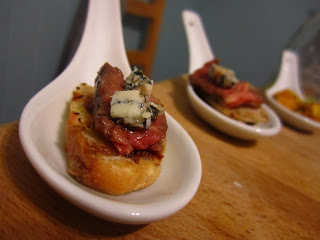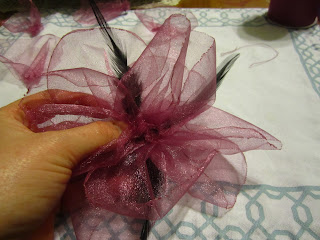Once upon a time, I discovered a recipe on the back of a magazine for homemade Easter eggs. Being the crafty yet frugal person that I am, I decided to give it a go and present my family with personalized treats. The original recipe called for making eggs of quite a large size, and I soon discovered that a person can only consume so much sweet, sticky Easter egg before being overcome by something akin to nausea. I decided that year that the recipe was flawed and needed tweaking. Thus began my love/hate relationship with Easter pudding eggs.
It's been about 14 years in the works, but after years of testing and tasting, making and remaking, I've finally creating an egg that I am proud of. No, scratch that. I've created eggs that I am proud to say came from my kitchen. And they're delicious. And bite-size.
The basic recipe itself is very good and results in a filling not unlike a fondant, but it's awfully sweet and can only be consumed in small quantities. It's basically a mix of pudding mix, hot water, icing sugar and fat. Originally, I made it with margarine, but have come to hate margarine, never have it in my house, and buy it only to make these eggs. So I tried butter and it worked. Now I use butter.
I use my trusty 1-inch spring-loaded ice cream scoop to portion out the dough into bite-sized pieces. This is really the ideal size as larger eggs are too much sugar in one sitting, and smaller eggs are cute but much more fussy when it comes to coating, and generally not worth the effort. A rounded 1 teaspoon measuring spoon also works well to portion the dough.
What I changed this year was the flavoring of the eggs. I've always just gone with the flavor of the pudding mix and called it a day. This time, I thought, why not use the pudding as a base, and build on it? Lots of things go with vanilla, and can possibly overpower it to create a completely different flavor altogether. So I embrace the idea of changing the filling of my Easter eggs. 
I tossed coconut flakes and flavoring into one part, lemon zest and
juice with yellow food coloring into a second part, and turned the third
into a marzipan with almond flavoring and ground almonds. All three were delicious and flavorful and surprisingly less sweet. 
Next, I played around with the chocolate batch, with less overall success. I tried peanut butter, which tasted AMAZING but changed the overall texture and consistency of the dough. I made a chocolate-orange filling with orange juice and candied peel, but the flavor didn't jump out at me the way the lemon did. I chopped up dried cranberries and toss those in, but it just became a chocolate filling with dried cranberries. OK, but not blowing my tastebuds away.
I rolled out the balls of dough into egg shapes, place them on baking sheets and set them in the fridge to chill overnight. This step is essential, as I have learned in past attempts that soft centers melt in hot chocolate. Chilling overnight breaks up the work, and I get less fed up of making all these eggs by the end of the weekend. Simply put, making 70-something Easter eggs become a less daunting task.
I melted a whole bunch of candy coating wafers in the microwave to coat the egg fillings. I use the 30 second heat-stir method, and the chocolate always comes out smooth. I also used white candy coating for some of the eggs.
The best dunking method I've discovered is using a brochette stick. I dip the stick in the melted chocolate then stab an egg filling.
I then dip the egg into the chocolate, swirling to coat completely. I gently tap the stick on the edge of the bowl to knock off any extra chocolate - an extra-thick shell throws off the balance with the filling.
I then push the egg down on a baking sheet lined with aluminum foil and carefully pull out the brochette stick, swirling the chocolate over the hole left behind.
Sometimes I just cover the hole with something - in this case, I topped these "marzipan" eggs with almond slivers, which tells what's inside, as well as making them look pretty.
I did the same for the rest of the flavors, since this time the insides, rather than the outsides changed. In the past, I have done different coatings while the filling remained the same. This also lets people know what to expect when they bite into an egg. I am not one of those "Life is like a box of chocolates" people. I like to know what I am eating.
These are lemon-filled, so I figured yellow sugar with white chocolate would do. In the background are the peanut butter ones - they have no decoration on top. After all, what would you put?
So the results of this year's experimentation, left to right: Marzipan, chocolate cranberry, coconut(tastes like a mounds bar!).
Again, left to right: chocolate and peanut butter, lemon, chocolate orange.
Previous years have included pastel-colored Easter eggs that were pretty to look at but rather plain and sugary to eat, and chocolate-covered eggs with yellow yolks in the middle. Also pretty, and challenging to make, but again, all sugar.
Easter Pudding Eggs (adapted from Kraft Canada)
1 package instant pudding mix (flavor of choice)
1/3 c. butter, softened
1/3 c. boiling water
3 c. icing sugar
8 oz. candy coating wafers
In a heat-proof bowl, place the pudding mix and the butter. Add the boiling water and stir until the butter is melted and the mixture is smooth. Add the icing sugar and mix until the dough forms a ball.
Using a 1-inch, spring-loaded ice cream scoop, portion out the dough into balls. Roll each ball into an egg shape and place on a foil-lined baking sheet. Place eggs in the fridge to chill overnight.
In a small glass bowl, heat chocolate candy coating wafers in the microwave for 30 seconds at a time, stirring after each, until melted. Dip egg centers into chocolate and place on foil-lined baking sheets to harden. Store in covered containers at room temperature.
Makes 36 eggs.
Varitions:
Coconut - use vanilla pudding mix. Add 3/4 c. unsweetened coconut flakes and 1 1/2 tsp. coconut flavoring to mix with boiling water.
Lemon - use vanilla pudding mix. Substitute 1/3 c. heated lemon juice for boiling water. Add zest of 1 lemon and 15 drops yellow food coloring to mix with heated lemon juice.
Marzipan - use vanilla pudding mix. Add 3/4 c. ground almonds and 1 1/2 tsp. almond flavoring to mix with boiling water.
Peanut Butter - use chocolate pudding mix. Add 1/2 peanut butter to the mix with the boiling water. You might have to add a bit more icing sugar to the dough to make it workable.
Orange - use chocolate pudding mix. Substitute 1/3 c. heated orange juice for the boiling water. Add 2 tbsp. chopped candied orange peel to the mix with the boiling water.
Cranberry - use chocolate pudding mix. Add 1/4 c. chopped dried cranberries to the mix with the boiling water.
Otherwise, go crazy! See what combination you can come up with - but don't forget to share!
A great way to present the finished eggs is in mini muffin paper liners, tucked into a recycled chocolate box. I always have a couple hidden in a cupboard somewhere just for this purpose. A few sheets of pretty paper glued on top, a nice ribbon tied up in a bow, and you have yourself an awesome Easter treat for the whole family!































































